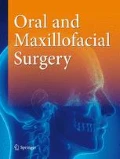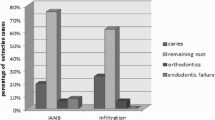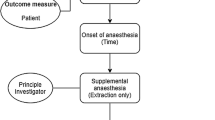Abstract
Aim
The aim of this study is to assess the efficacy of 4% articaine with 1:100,000 adrenaline given as buccal and lingual infiltration in adult patients undergoing erupted mandibular first and second molar teeth extraction versus inferior alveolar nerve block technique using 2% lignocaine with 1:80,000 adrenaline.
Materials and methods
A total of 100 patients undergoing extraction of mandibular posterior teeth were divided into two equally matched groups for the study, out of which 50 patients were given 4% articaine with 1:100,000 adrenaline as buccal and lingual infiltration and 50 patients were given 2% lignocaine with 1:80,000 adrenaline using classic direct inferior alveolar nerve block with lingual and buccal nerve block. Efficacy of anesthesia was determined using a numeric analog scale (NAS) ranging from 0 indicating no pain to 10 indicating the worst pain imaginable. The NAS was taken by a different operator to avoid bias.
Results
The pain scores in both groups were analyzed using the Mann–Whitney U test, and a p value of 0.338 was obtained which is not statistically significant. Hence, no significant difference in the pain score was established between both groups. The adverse effects of both the local anesthetics if any were noted.
Conclusion
From this study, we concluded that the use of 4% articaine with 1:100,000 adrenaline is as effective as inferior alveolar nerve block with lignocaine but without the risk of attendant adverse effects of inferior alveolar nerve block technique.

Similar content being viewed by others
References
Elliot V, Hersh H, Giannakopoulos L, Levin M, Stacey S, Paul A, Moore CP, Matthew H, Mohammed B, Ari M, Raymond RT (2006) The pharmacokinetics and cardiovascular effects of high-dose articaine with 1:100,000 and 1:200,000 epinephrine. J Am Dent Assc Vol 137:1562–1571
Dudkiewicz A, Schwartz S, Laliberte R (1987) Effectiveness of mandibular infiltration in children using the local anesthetic Ultracaine (articaine hydrochloride). J Can Dent Assn 1:29–31
Ram D, Amir E (2006) Comparison of articaine 4% and lidocaine 2% in pediatric dental patients. Int J Paediatr Dent 16(4):252–256
Malamed SF, Gagnon S, Leblanc D (2001) Articaine hydrochloride: a study of safety of a new amide local anesthetic. J Am Dent Assc 132:177–185
Malamed SF, Gagnon S, Leblanc D (2000) Efficacy of articaine: a new amide local anesthetic. J Am Dent Assoc 131(5):635–642
Nuzum FM, Drum M, Nusstein J, Reader A, Beck M (2010) Anesthetic efficacy of articaine for combination labial plus lingual infiltrations versus labial infiltration in the mandibular lateral incisor. J Endod 36(6):952–956
Malamed SF Handbook of local anesthesia. Fifth edition Mosby Publishers page no.227 and page no.71
Rosenberg AP, Ketan GA, Yigal Z, Louis ML (2007) Comparison of 4% articaine with 1:100,000 epinephrine and 2% lidocaine with 1:100,000 epinephrine when used as a supplemental anesthetic. J Endod 33(4):403–405
Corbett IP, Kanaa MD, John MW, John GM (2008) Articaine infiltration for anesthesia of mandibular first molars. J Endod 34:514–518
Douglas R, John N, Reader A, Beck M, Melissa MC (2007) The anesthetic efficacy of articaine in buccal infiltration of mandibular posterior teeth. J Am Dent Assoc 138(8):1104–1112
Il-Jung Y, Kim JH, Kim E-S, Lee CL, Lee SJ (2008) An evaluation of buccal infiltrations and inferior alveolar nerve blocks in pulpal anesthesia for mandibular first molars. J Endod 34:11–13
Yapp KE, Hopcraft MS, Parashos P (2011) Articaine: a review of literature. Br Dent J 210(7):323–329
Vahatalo K, Antila H, Lehtinen R (1993) Articiane and lidocaine for maxillary infiltration anesthesia. Anesth Prog 40(4):114–116
Nusstein J, Berlin J, Reader A, Beck M, Weaver JM (2004) Comparison of injection pain, heart rate increase, and postinjection pain of articaine and lidocaine in a primary intraligamentary injection administered with a computer-controlled local anesthetic delivery system. Anesth Prog 51(4):126–133
Nusstein J, Reader A, Beck M, Weaver JM (2005) A comparison of articaine and lidocaine for inferior alveolar nerve blocks. J Endod 31(4):265–270
Oliveira PC, Volpato MC, Ramacciato JC, Ranali J (2004) Articaine and lignocaine efficiency in infiltration anaesthesia: a pilot study. Br Dent J 197(1):45–46
Oertel R, Rahn R, Kirch W (1997) Clinical pharmacokinetics of articaine. Clin Pharmacokinet 33:417–425
Carlos FS, CSM K, PMGiglio F, Vivien TS, Adriana MC (2007) Epinephrine concentration (1:100,000 or 1:200,000) does not affect the clinical efficacy of 4% articaine for lower third molar removal: a double-blind, randomized, crossover study. J Oral Maxillofac Surg 65(12):2445–2452
Giovanarado M, Juliana CR, Patricia CO, Maria CV (2003) Comparison of effectiveness of 4% articaine associated with 1:100,000 or 1:2,00,000 epinephrine in inferior alveolar nerve block. Anesth Prog 50:164–168
Mayes ME, John N, Melissa D, Al R (2011) Anesthetic efficacy of 4% articaine with 1:100,000 epinephrine versus 4% articaine with 1:2,00,000 epinephrine as a primary buccal infiltration in the mandibular first molar. J Endod 37(4):588–592
Simon MA, Gielen MJ, Alberink N, Vree TB, van Egmond J (1997) Intravenous regional anesthesia with 0.5% articaine, 0.5% lidocaine, or 0.5% prilocaine. A double blind randomized clinical study. Reg Anesth Pain Med 22(1):29–34
Haas DA, Lennon D (1995) A 21 year retrospective study of reports of paresthesia following local anesthetic administration. J Can Dent Assoc 61:319–330
Hillerup S, Jensen R (2006) Nerve injury caused by mandibular block analgesia. Int J Oral Maxillofac Surg 35(5):437–443
Meechan JG (2002) Supplementary routes to local anaesthesia. Int Endod J 35:885–896
Author information
Authors and Affiliations
Corresponding author
Ethics declarations
Conflict of interest
The authors declare that they have no conflict of interest.
Rights and permissions
About this article
Cite this article
Venkat Narayanan, J., Gurram, P., Krishnan, R. et al. Infiltrative local anesthesia with articaine is equally as effective as inferior alveolar nerve block with lidocaine for the removal of erupted molars. Oral Maxillofac Surg 21, 295–299 (2017). https://doi.org/10.1007/s10006-017-0628-z
Received:
Accepted:
Published:
Issue Date:
DOI: https://doi.org/10.1007/s10006-017-0628-z




